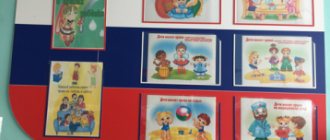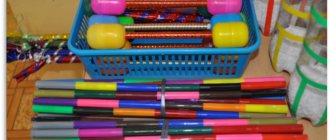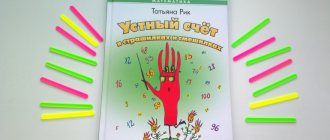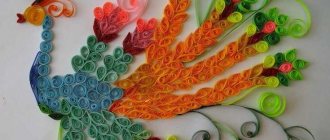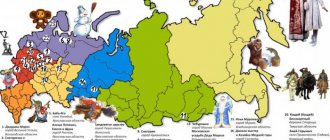“Types and forms of educational activities in preschool educational institutions according to the Federal State Educational Standard” consultation
Report on the topic:
“Types and forms of educational activities in preschool educational institutions according to the Federal State Educational Standard”
Prepared by the teacher:
Petintseva I. A.
Saratov 2020
Organized educational activity (OEA) is the leading form of organizing joint activities between adults and children, which is determined by the level of mastery of the general education program of preschool education and the solution of specific educational problems with the age of the children, the immediate environment of the educational institution, the current topic, etc. But the learning process remains. Teachers continue to “work with children. The Federal State Educational Standard for Preschool Education is based on the most important didactic principle - proper organized education leads to development, the result of which is the success of the upbringing and education of children in preschool educational institutions. OOD – connects the teaching function and joint activities. Standardization of preschool education does not provide for the presentation of strict requirements for children of preschool age, does not consider them within a strict “standard” framework.
Criteria for assessing the quality of educational activities in accordance with the Federal State Educational Standard for Education:
- Creating conditions for preserving and strengthening the health of children;
- Compliance of the goals and objectives of educational activities with the Federal program and the main general education program of the preschool educational institution;
- Implementation of a set of tasks: training, development, educational;
- Integration of educational areas.
Integration of areas of development and education of children (Educational areas):
- Social and communicative development
- Cognitive development
- Speech development
- Artistic and aesthetic development
- Physical development
One of the main features of conducting educational practice is the correct, clearly justified choice of the type of educational activity in a preschool educational institution according to the Federal State Educational Standard, the methods used and forms of interaction with students. Due to the fact that the design of educational activity must be ensured throughout the entire time preschoolers are in kindergarten, educators are recommended to use pedagogical design tools to:
- Formulate the strategic goal of organizing the educational process - it must be clear (so that at the end of the reporting period it is possible to unambiguously answer about the fact of its achievement), relevant (respond to significant problems), real (located in the zone of proximal development of students).
— Specify the objectives of educational work, taking into account the program content and individual developmental characteristics of preschool children.
- Select the optimal means, methods and forms of educational activities according to the Federal State Educational Standard in preschool educational institutions, which allow you to increase the status of the game as the main way of understanding the world, consistently implement search, research, experimental projects, and design problem-based learning situations.
— Systematically conduct self-analysis of teaching activities, adjust teaching and educational methods taking into account the real situation. When carrying out planning work, during the development of the goals and objectives of educational activities, it is important for the teacher to take into account the possibility of unplanned situations that change the course of the educational process, and to respond adequately to these events. For this purpose, it is necessary to actively apply innovative types, methods and forms of organized educational activities.
Types of educational activities in preschool educational institutions according to Federal State Educational Standards
Combined: involves combining into one complex various types of activities that do not have reasonable logical connections between each other (modeling and outdoor play). The integrity of the pedagogical impact can be achieved by choosing a single topic.
Complex: organization of various types of activities, one of which stands out as the main one, and the rest serve as auxiliary components. So, after a conversation about the rules of behavior in public transport, the teacher can offer to create drawings on the topic.
Integrated: based on a combination of knowledge from different subject areas for a comprehensive consideration of the issue, for example, familiarization with the concept of “mood” while reading a literary work, looking at illustrations, listening to music.
Special attention should be paid to the forms of educational activities in preschool educational institutions according to the Federal State Educational Standard, which differ not only in the quantitative composition of participants, but also in the nature of interaction:
1. Individual, providing for pedagogical work with one child. It does not require a lot of time, but is characterized by uneconomical allocation of resources, limits the possibility of active interaction with other children and can provoke emotional discomfort.
2. Group (individual-collective). To implement it, children are divided into subgroups taking into account common interests or assigned tasks, while the main task of the teacher is to ensure their effective interaction.
3. Frontal (work with the whole group). It is attractive due to its unity of content, clarity of organizational structure, ease of management, and economical distribution of teaching resources, but does not allow individualization of training.
Forms of OOD according to the Federal State Educational Standard, implemented in preschool educational institutions according to the current principles of the Federal State Educational Standard within the framework of regime issues, also include:
- outdoor games with rules, active breaks, physical education minutes, sports jogging, game exercises;
— health-preserving and hardening measures;
— creative, experimental, exploratory projects, walks along the eco-trail;
- competitions, holidays, parent-child days, children's creativity workshops, work in mini-museums;
— mini-lectures, conversations, computer presentations;
- retellings, writing, learning small folklore forms and poems, speech situations;
- organized role-playing, constructive, theatrical, creative games, dramatizations;
— work on the site, duty, practical experiments and experiments;
- collecting, modeling, listening to music, musical improvisation, rhythm classes.
Summary of OOD on cognitive development in the senior group of kindergarten
Summary of OOD on cognitive development in the senior group “Visiting Pochemuchka. Why does a hare have big ears... and what do they look like?
Integration of educational areas: “Speech development”, “Physical development”, “Social and communicative development”, “Artistic and aesthetic development”
Goal: - consolidate and expand children's knowledge about wild and domestic animals using the example of hares. Objectives: Educational:
- increase children’s speech activity;
enrich vocabulary; — clarify children’s understanding of the inhabitants of the forest; Developmental:
- develop children's attention, memory, logical thinking, observation;
- develop imagination and creativity. Educational:
- cultivate cognitive interest, respect for nature;
Methods and techniques: 1. Practical (making a picture from a puzzle, physical education); 2. Visual (demonstration of paintings, illustrations, presentations); 3. Verbal (stories, conversations, riddles). Preliminary work: Examination of illustrations depicting a forest, forest animals; reading the fairy tale “The Owl” by V. Bianchi; game based on a fairy tale; reading the works of E. Charushin “Hare”, “Fox”, “Wolf”. Reading the story “Hares” by L. Tolstoy. Materials and equipment: computer, projector, screen, paintings depicting a hare and domestic rabbits, a “magic” suitcase;
color pictures depicting wild animals, presentation “Why does a hare have long ears?” Vocabulary work: herbivore (herbivore), varied colors, adapted, lop-eared, sighted, mouthpiece, upright. Course of the lesson
1. Open entrance to the activity. Game motivation. Psychological attitude “Chain of Friendship” Children stand in a circle. Educator: (addresses the children) “Rub your palms, feel the warmth! Imagine that there is a small ball between your palms, let’s roll it! Now let’s share the warmth with each other: extend your palms to your neighbors! We have created a “chain of friendship”! Let’s smile and wish each other good luck!” 2. Introductory and organizational. Introductory conversation. Educator: Children, today our beloved Pochemuchka is visiting us. You know he loves to ask questions. And for correct answers he gives something. We all love gifts, so we will try to answer all his questions. (Pochemuchka enters. He has a suitcase in his hands.) 3. Motivation for activity. Creating a problematic situation, Pochemuchka: Hello, guys! Today I brought you a gift. This is a picture from a puzzle. But I will give it to you for the correct answers to my questions. For each correct answer you get one piece of the picture (1 puzzle). Are you all ready? Begin! 4. Explaining something new or expanding existing knowledge. Activation of independent thinking. Question: Guess who we're talking about: What kind of forest animal is it? Stood up like a post under a pine tree And stands among the grass - Ears larger than head. (Hare) Question: Write a story about a hare, completing the sentences. - The hare lives in the forest in ... (hole). - In summer the hare is .... (gray), and in winter .... (white). - The hare has long .... (ears). - Round... (head). - The front legs are shorter than .... (hind) - The hind legs are adapted for .... (jumping) - The tail is .... (small). - Up the mountain the hare ..... (runs), and from the mountain .... (somersaults). — The hare has a warm, light…..(fur coat). - The hare is afraid of... (fox, wolf, dog, people). — The hare loves to eat...(cabbage, carrots, turnips, grass, tree bark). - The hare quickly .... (runs), deftly ..... (jumps), but does not know how ..... (swim and climb trees). — A hare gives birth to ... (babies) in the summer. Question: Hares are herbivores. What does it mean? Children: Hares eat only plant foods: leaves, stems, roots, bark of young trees, fruits. They also eat mushrooms, but their favorite delicacy is aspen bark. For hares it is sweeter than sugar. Where there is an aspen tree fallen by the wind, the hares will gnaw the bark clean. The teeth of hares are suitable for this. Question: What can you say about cleft teeth? Children: The hare's teeth are large and flat - for feeding, not for attacking. Question: What is a hare usually called in fairy tales? Children: Cowardly bunny. Educator: I immediately want to justify the hares. Everyone thinks they are cowards. But this is not so. A ten-day-old hare fights off a magpie or crow by standing on its hind legs, waving its front legs and screaming loudly to intimidate. In the same way, their mother protects them from feathered enemies. And if the enemy attacks from the air, the hare falls onto her back and tries to rip open the attacker’s belly with her hind legs. The fox and marten are distracted from the hares by running around and firmly beating their feet on the ground. Happens and dies saving children. So, it’s a shame for the hares, they were unfairly classed as cowards. And the fact that they, having heard a rustle, take off from their place and run away is not cowardice, but animal wisdom: it is stupid to stand still waiting to be eaten. There is a Russian proverb about this: “The hare is not a coward, he takes care of himself.” 5. Dynamic pause. Gaming techniques. Finger gymnastics “Bunny” Look at that finger! Jumps deftly like a bunny. On a log and on a stump Jump and jump and jump and jump! (Children clench their hands into fists, stretching out two fingers and bending them. Then they make jumping movements with their hands.) Physical exercise: The bunny went out for a walk. The wind began to subside (walking in place)
The little bunny was tired.
He wants to hide in the bushes (squat)
So he gallops down the slope, runs into the green forest and rushes between the trunks, among the grass, flowers, bushes.
(jumping in place)
The bunny froze in the middle of the grass, And now we will freeze too!
(children sit down in their places) Question: He lives in a barn, in a cage, gnawing on sweet carrots. Oh, and sharp teeth, He is always in a fluffy fur coat, Lop-eared, tail like a zero. Everyone recognized him... Children: Rabbit. Question: Tell us about the rabbit (show picture) Children: Rabbits are a completely different animal - a domestic one. They resemble a hare. The body is covered with fur. They have long ears, short tails, and move by jumping. They have very sharp and long front teeth. Educator: I'll help. Both rabbits and hares are herbivores. In addition to various plants, they like to gnaw bark from trees. Domestic rabbits have long lived near a man who bred many different breeds of rabbits. Domestic rabbits come in a variety of colors (gray, white, black) and do not change coat color in the winter like a hare. Question: Tell us what differences there are between hares and rabbits. Children: The hare is gray in summer and white in winter. He does not dig holes and cannot live in one place for a long time. Hares are larger and have longer legs and ears. Hares are born sighted and covered with fur. Rabbits have a variety of colors. The rabbit digs holes and constantly completes them. The ears and front legs are shorter than those of a hare. Rabbits are born naked and blind, and are cared for by their mother. Why: I have something else in my suitcase. This is a megaphone. Why does he need it? Answer the question first. Question: Why do the hare have big ears? Children: The hare has the best hearing. The hare presses down to the ground, raises its ears vertically and, remaining invisible, learns about everything that is happening far around. Educator: But if it rains, you have to fold your ears, bend them so that water does not get into them and so as not to get sick. So in the rain, he has to stick his head out to find out the situation, which is extremely dangerous for the hare’s life. The ears of a hare have another remarkable feature - they are a kind of refrigerator. In extreme heat, they save the hare from overheating - through the thin, large ears the hare loses a third of its heat, and it does not need to stick out its tongue, as a dog does. The ears have another purpose, which helps the hare get rid of excess heat in the body and prevent overheating during a long chase. And in winter, when it’s cold, he presses his ears to his back, in order, on the contrary, to prevent loss of heat. Question: What do a hare and a bullhorn have in common? Children: A hare's ears look like a megaphone. The larger the ears, the better you can hear. Educator: Long, so as not to interfere with running. The hare throws them back. Let's watch the presentation “Why do the hare have long ears?” Showing the presentation “Why does a hare have long ears?” Why: Guys, I liked your interesting stories. We learned a lot of new and interesting things. I say thank you, goodbye. See you again! 6. Open withdrawal from activity. Discussion of results Educator: - Children, what did you like about the lesson? — What new and interesting things did you learn? - Guys, if you liked our lesson, then take a red ball, if you didn’t like it, then take a blue ball.
We recommend watching:
Summary of a lesson on cognitive development in the senior group. Our assistants Summary of OOD on constructive-model activities for children of the senior group Summary of a lesson in the senior group on the topic “Street of the native city” Summary of an integrated lesson on FEMP using Dienesh blocks for children of the senior group
Similar articles:
Lesson notes for the senior group of kindergarten. Kingdom of Three Minerals
World of Psychology
The indicative basis of an action is a system of conditions on which a person actually relies when performing an action.
The indicative basis of action is a necessary component of any action. The fact is that every action we perform will be successful only if we take into account the conditions that determine the success of this action.
For example: a child needs to write the capital letter “B”. He will be able to achieve this goal only if he takes into account the relationship of the elements of this letter, their location on the plane of the sheet in relation to the lined notebook. If a person takes into account the entire system of conditions that are objectively necessary, then the action will achieve this goal. If a person focuses on part of these conditions or replaces them with others, then the action will lead to mistakes.
OOD scheme:
- Acquaintance with new activities and the knowledge included in them. Highlight all the necessary knowledge about the subject with which you need to act. Identify knowledge about the process of activity itself: where to start, in what order to perform actions.
- Fixation of the selected content of the activity. It is necessary not only to understand the content of the activity being introduced, but also to learn how to perform it correctly.
- Stages of performing the activity being formed: the stage of performing actions in a materialized (material) form; stage of external speech actions; the stage of performing an action in external speech “to oneself” and the stage of mental actions.
The indicative part of the action is aimed at:
- on the correct and rational construction of the executive part
- to choose from one of the possible designs
The second function of the orienting part of the action clearly appears when analyzing actions associated with the game of chess. The approximate part of the action should ensure the correct choice of the next move. When performing the orienting part of an action, a person must use for orientation not only a system of conditions that ensure the correct relocation of a piece from field to field (the executive part of the action), but also those features of chess positions that determine the choice of the next move.
A person, performing the indicative part of the action, relies on the indicative basis of the action (IBA). The success of the indicative part of the action depends, first of all, on the content of the indicative basis. The approximate basis of action can be complete, incomplete, redundant.
